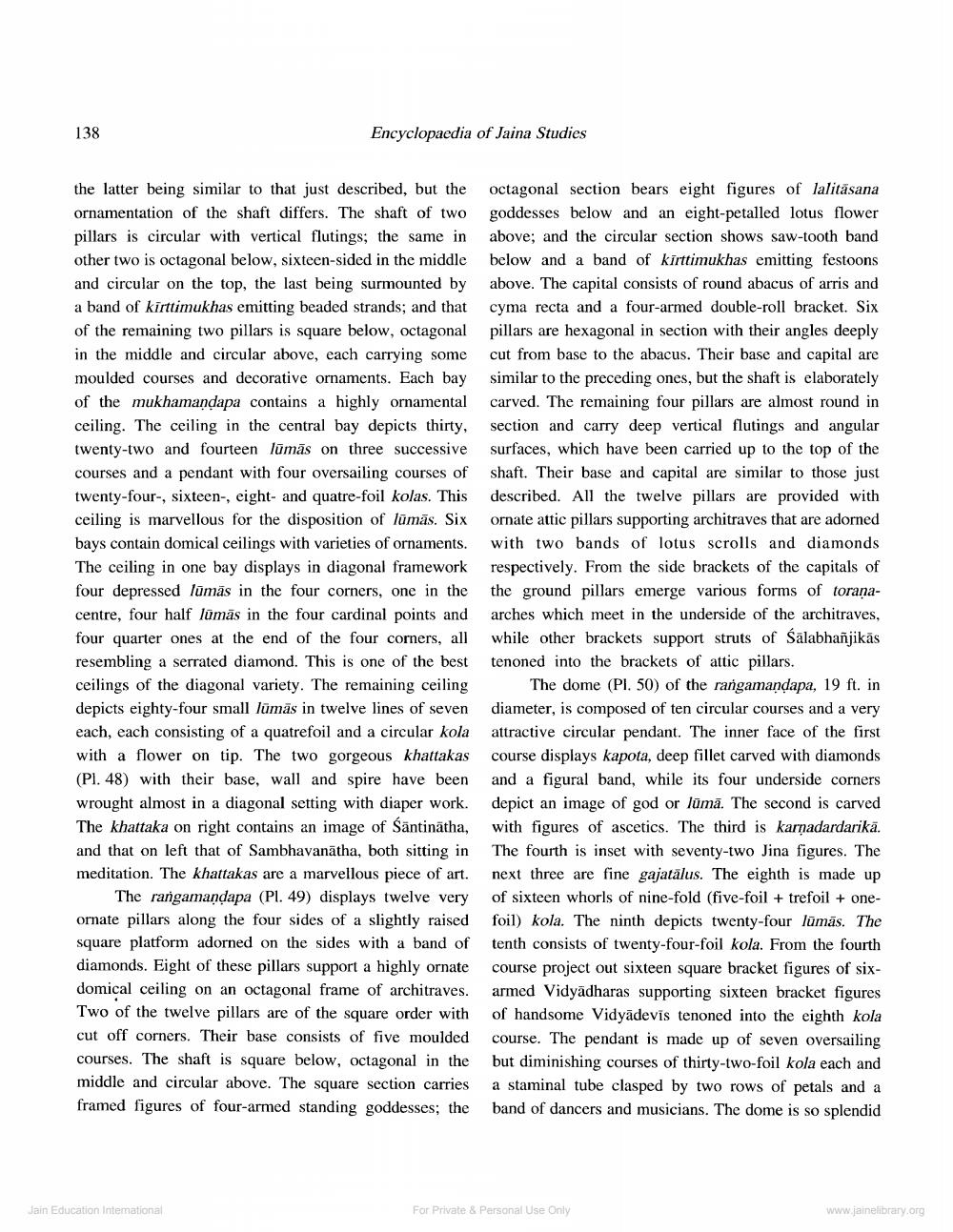________________
138
Encyclopaedia of Jaina Studies
the latter being similar to that just described, but the ornamentation of the shaft differs. The shaft of two pillars is circular with vertical flutings; the same in other two is octagonal below, sixteen-sided in the middle and circular on the top, the last being surmounted by a band of kīrttimukhas emitting beaded strands; and that of the remaining two pillars is square below, octagonal in the middle and circular above, each carrying some moulded courses and decorative ornaments. Each bay of the mukhamandapa contains a highly ornamental ceiling. The ceiling in the central bay depicts thirty, twenty-two and fourteen lūmās on three successive courses and a pendant with four oversailing courses of twenty-four-, sixteen-, eight- and quatre-foil kolas. This ceiling is marvellous for the disposition of lūmās. Six bays contain domical ceilings with varieties of ornaments. The ceiling in one bay displays in diagonal framework four depressed lūmās in the four corners, one in the centre, four half lümās in the four cardinal points and four quarter ones at the end of the four corners, all resembling a serrated diamond. This is one of the best ceilings of the diagonal variety. The remaining ceiling depicts eighty-four small lūmās in twelve lines of seven each, each consisting of a quatrefoil and a circular kola with a flower on tip. The two gorgeous khattakas (Pl. 48) with their base, wall and spire have been wrought almost in a diagonal setting with diaper work. The khattaka on right contains an image of Sāntinātha, and that on left that of Sambhavanātha, both sitting in meditation. The khattakas are a marvellous piece of art.
The rangamandapa (PL. 49) displays twelve very ornate pillars along the four sides of a slightly raised square platform adorned on the sides with a band of diamonds. Eight of these pillars support a highly ornate domical ceiling on an octagonal frame of architraves. Two of the twelve pillars are of the square order with cut off corners. Their base consists of five moulded courses. The shaft is square below, octagonal in the middle and circular above. The square section carries framed figures of four-armed standing goddesses; the
octagonal section bears eight figures of lalitasana goddesses below and an eight-petalled lotus flower above; and the circular section shows saw-tooth band below and a band of kīrttimukhas emitting festoons above. The capital consists of round abacus of arris and cyma recta and a four-armed double-roll bracket. Six pillars are hexagonal in section with their angles deeply cut from base to the abacus. Their base and capital are similar to the preceding ones, but the shaft is elaborately carved. The remaining four pillars are almost round in section and carry deep vertical flutings and angular surfaces, which have been carried up to the top of the shaft. Their base and capital are similar to those just described. All the twelve pillars are provided with ornate attic pillars supporting architraves that are adorned with two bands of lotus scrolls and diamonds respectively. From the side brackets of the capitals of the ground pillars emerge various forms of toranaarches which meet in the underside of the architraves, while other brackets support struts of Salabhanjikās tenoned into the brackets of attic pillars.
The dome (Pl. 50) of the rangamandapa, 19 ft. in diameter, is composed of ten circular courses and a very attractive circular pendant. The inner face of the first course displays kapota, deep fillet carved with diamonds and a figural band, while its four underside corners depict an image of god or lūmā. The second is carved with figures of ascetics. The third is karnadardarikā. the fourth is inset with seventy-two Jina figures. The next three are fine gajatalus. The eighth is made up of sixteen whorls of nine-fold (five-foil + trefoil + onefoil) kola. The ninth depicts twenty-four lūmās. The tenth consists of twenty-four-foil kola. From the fourth course project out sixteen square bracket figures of sixarmed Vidyadharas supporting sixteen bracket figures of handsome Vidyādevis tenoned into the eighth kola course. The pendant is made up of seven oversailing but diminishing courses of thirty-two-foil kola each and a staminal tube clasped by two rows of petals and a band of dancers and musicians. The dome is so splendid
Jain Education Intemational
ducation Intermational
For Private & Personal Use Only
For Private & Personal Use Only
www.jainelibrary.org




